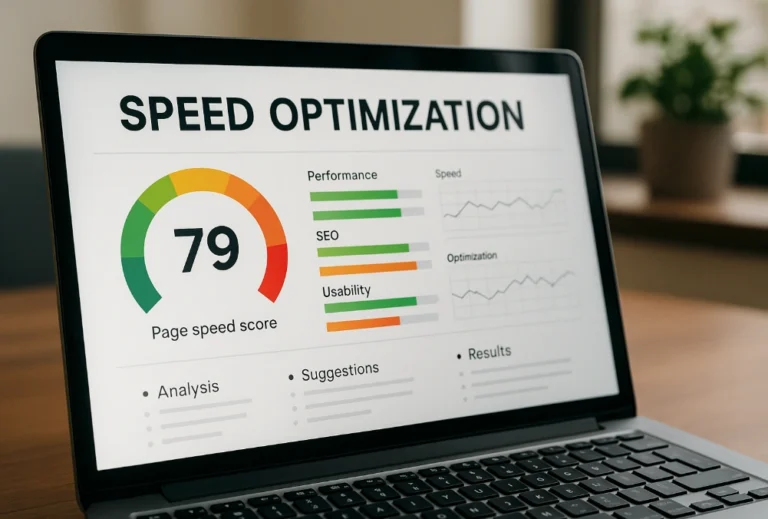If you’ve ever wondered why your website’s search rankings fluctuate—or why some pages load lightning-fast while others crawl—you’re not alone. Enter Core Web Vitals, Google’s way of measuring how users experience your site.
These metrics go beyond just loading speed—they assess how quickly content becomes usable, how stable the layout is, and how smoothly users can interact with your pages.
Understanding these factors is now essential, not just for user satisfaction but for SEO success.
In this guide, you’ll find what Core Web Vitals are, why they matter, and how they can make or break your site’s visibility in search.
What Are Core Web Vitals?

Core web vitals & user experience are interconnected. Core Web Vitals are a set of specific factors that Google considers essential in a webpage’s overall user experience. These performance metrics help webmasters understand how users perceive the speed, responsiveness, and visual stability of a site.
Introduced as part of Google’s page experience update, Core Web Vitals have become a key component in determining search rankings. The three main metrics that make up Core Web Vitals are Largest Contentful Paint (LCP), First Input Delay (FID), and Cumulative Layout Shift (CLS)—each measuring a different aspect of user experience.
Now what are the core web vitals? Here’s your guide to everything about them:
Largest Contentful Paint (LCP)
Core web vitals LCP measures the time it takes for the largest visible content element on a page to load. This could be a banner image, heading, or block of text. A fast LCP reassures users that the page is useful and worth staying on.
Ideally, your site’s LCP should occur within 2.5 seconds of the page starting to load. Poor LCP scores can result from slow server response times, render-blocking resources, or large file sizes. Optimizing images, improving server speed, and reducing third-party scripts can help improve this metric.
First Input Delay (FID)
FID evaluates how long it takes for a page to respond to a user’s first interaction—like clicking a button or tapping a link. This metric reflects interactivity and usability. An ideal FID score is less than 100 milliseconds.
High FID values can frustrate users, especially on mobile devices, and are often caused by heavy JavaScript execution. To optimize FID, reduce JavaScript execution time, break up long tasks, and prioritize essential code to make the page more responsive.
Cumulative Layout Shift (CLS)
CLS core web vitals measures how often users experience unexpected layout shifts while a page is loading. These sudden movements can be annoying—imagine trying to click a link and the page jumps, causing you to tap something else.
A good CLS score is less than 0.1. Layout shifts usually occur when elements like images or ads load without defined dimensions. To fix this, always include size attributes for media, avoid inserting content above existing elements, and use reserved space for dynamic components.
Why Are Core Web Vitals Important?
Core Web Vitals play a vital role in ensuring that websites provide fast, responsive, and visually stable experiences. Google’s core web vitals use these metrics as a core web vitals ranking factor to reward websites that prioritize user experience.
- Websites that meet Core Web Vitals benchmarks are more likely to appear higher in search results.
- Improving these metrics can reduce bounce rates and increase the time users spend on your site.
- Core Web Vitals help build trust with users, making them more likely to return and engage with your content.
How Do Core Web Vitals Affect User Experience?

Core Web Vitals directly impact how users perceive your site—whether it’s fast, responsive, and smooth or slow and frustrating. Each metric corresponds to a real-world user interaction that can influence satisfaction and engagement.
Faster Load Times (LCP)
When content loads quickly, users can start reading or interacting with the page almost immediately. A slow LCP can make your site feel sluggish and discourage visitors from staying.
Immediate Responsiveness (FID)
Pages that respond quickly to user input feel more seamless and intuitive. A high FID can cause delays and make a site feel unresponsive, especially on mobile devices.
Stable Visual Layouts (CLS)
Preventing unexpected layout shifts ensures users don’t accidentally click the wrong elements. A low CLS score creates a smoother, frustration-free browsing experience.
What Is the Relationship Between Core Web Vitals and SEO?
Core web vitals impact on SEO have become part of Google’s Page Experience signals, meaning they directly influence how your website ranks in search results. While high-quality content and relevant keywords remain key, Google now prioritizes pages that also deliver a fast and smooth user experience.
This shift means technical performance is no longer optional—it’s essential. By improving Core Web Vitals, you’re not only optimizing your site for visitors but also boosting its potential to rank higher and compete effectively in search engine results.
Can Core Web Vitals Improve Website Rankings?
Yes, Core Web Vitals can positively influence your website’s rankings, especially when your site is competing with others that offer similar content quality.
Google considers user experience to be a key ranking factor, and pages that load quickly, respond smoothly, and maintain layout stability are more likely to rank higher.
While Core Web Vitals alone won’t make up for poor content or irrelevant keywords, they can give your site the edge it needs in a competitive search landscape.
How Can You Measure Core Web Vitals?
Monitoring your Core Web Vitals helps you understand which areas of your site need improvement to enhance user experience and SEO. Google provides several core web vitals tools that give real-time and historical performance insights.
- PageSpeed Insights evaluates individual pages and offers both lab and field data with suggestions for improvement.
- Google Search Console provides Core Web Vitals reports across your entire site, helping you track which URLs need attention.
- Lighthouse is a developer tool in Chrome DevTools that audits performance, accessibility, and SEO, including Core Web Vitals scores.
What Are the Best Practices for Improving Core Web Vitals?
Improving Core Web Vitals involves both frontend and backend optimizations that boost your site’s speed, responsiveness, and visual consistency. Here are some best practices to help you meet Google’s recommended thresholds.
Optimize Images and Media
Large or uncompressed images are one of the most common causes of poor LCP scores. Use modern formats like WebP and ensure images are responsive and lazy-loaded. Compressing images and setting explicit dimensions can also enhance load times and reduce layout shifts.
Minimize JavaScript and Third-Party Code
Heavy JavaScript execution can delay FID and make your site feel unresponsive. Break up long tasks, defer non-critical scripts, and remove unused JavaScript. Limiting third-party tools like ads or chat widgets can also reduce delays and layout instability.
Use Efficient CSS and Set Size Attributes
Clean, efficient CSS can speed up rendering and contribute to layout stability. Always define width and height for images and video elements to prevent unexpected layout shifts. Preloading key resources and using font-display: swap can also help your site load smoothly and stay visually consistent.
Why Is Mobile Optimization Important for Core Web Vitals?

With the majority of web traffic now coming from mobile devices, optimizing for mobile performance is crucial for both user satisfaction and search visibility. Core Web Vitals are especially important on mobile, where slower connections and limited processing power can quickly expose poor site performance.
Smaller Screens Mean Less Room for Error
Elements that load or shift unpredictably are more disruptive on small screens. Ensuring visual stability (CLS) on mobile is essential to avoid frustrating user experiences.
Slower Networks Amplify Load Issues
Mobile users often browse on slower or inconsistent connections, making load speed (LCP) even more critical. A few extra seconds of delay can lead to higher bounce rates.
Touch Interactions Require Fast Response
On mobile, users expect instant feedback from taps and swipes. Poor responsiveness (FID) can create lag that breaks the user journey and reduces engagement.
How Does Core Web Vitals Impact Conversion Rates?
A well-optimized website not only keeps users engaged but also drives conversions. When visitors experience fast load times, smooth interactions, and stable layouts, they’re more likely to trust your brand and complete desired actions—whether it’s a purchase, sign-up, or download.
Core Web Vitals create a seamless user experience that encourages users to stay, explore, and convert.
- Faster load times reduce bounce rates and increase the chances of users completing forms or purchases.
- A stable layout builds trust and keeps users from accidentally clicking the wrong elements.
- Improved interactivity makes the site feel more modern and user-friendly, boosting satisfaction.
- Optimizing Core Web Vitals can reduce friction across the conversion funnel and lead to measurable revenue growth.
What Are Common Mistakes That Affect Core Web Vitals?
Even well-intentioned websites can fall short on Core Web Vitals due to avoidable mistakes. Recognizing and fixing these issues is key to boosting performance and user experience.
Not Setting Image Dimensions
Failing to set height and width attributes causes layout shifts during loading. This significantly affects CLS and can make your page feel unstable.
Heavy JavaScript or CSS
Bulky code can block rendering and delay interactivity. This directly impacts both LCP and FID scores.
Too Many Third-Party Scripts
While tools like chatbots or ad scripts can be helpful, too many slow down your site; they can interfere with user interactions and cause delays in page load times.
Take Charge of Core Web Vitals with LeadOrigin
Core Web Vitals directly impact your search visibility, user engagement, and conversion rates. By optimizing these metrics, you ensure that your site not only ranks higher but also delivers an exceptional experience across all devices.
Partner with LeadOrigin to take the guesswork out of performance optimization. Our expert team can help on how to improve core web vitals as we use cutting-edge tools and data-driven strategies and elevate your SEO game.
Whether you’re aiming for faster load times, better interactivity, or a seamless mobile experience, LeadOrigin is here to help you thrive online and provide reliable solutions to optimize for core web vitals. Get started with LeadOrigin today and see the results!






